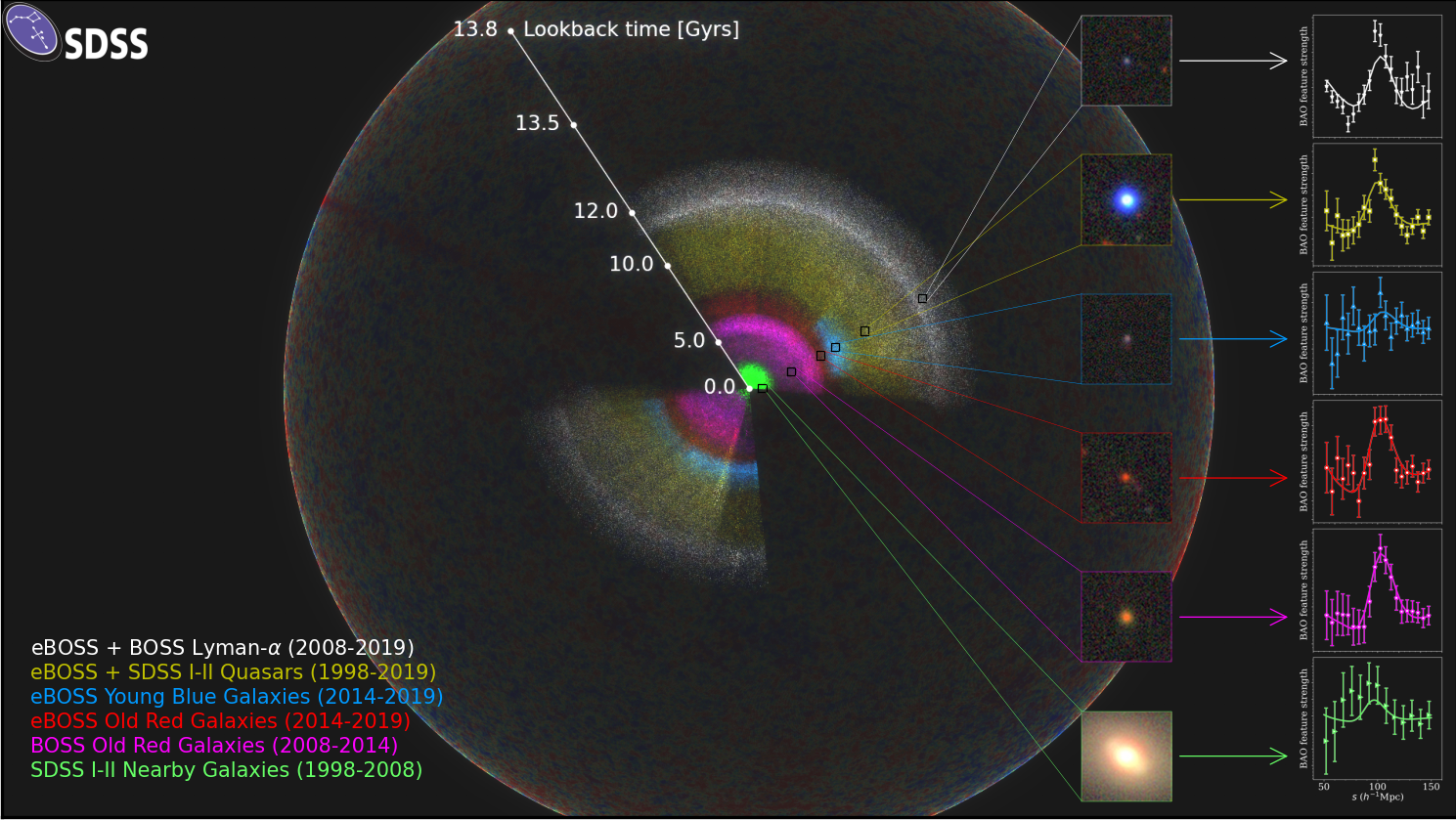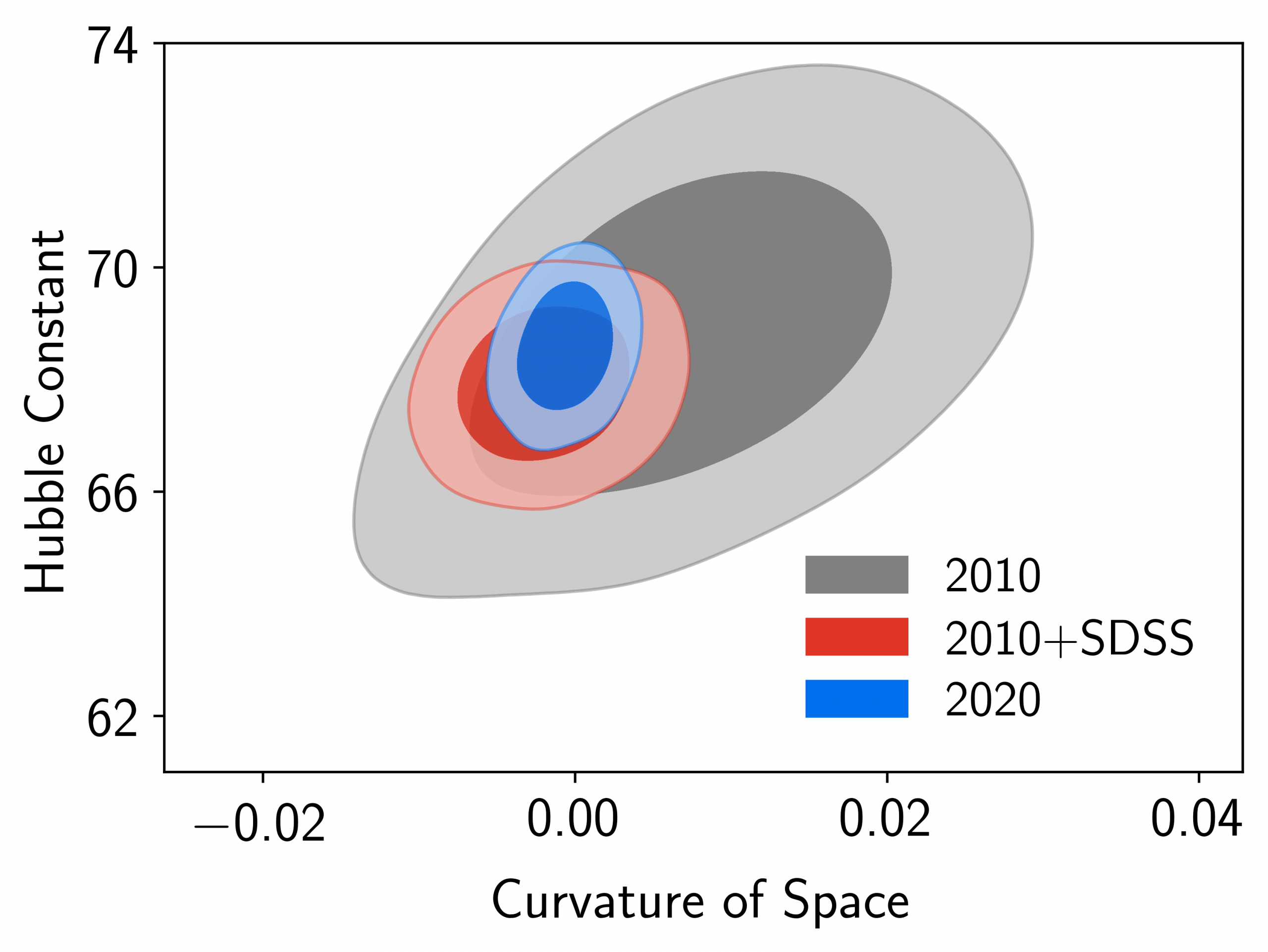The Sloan Digital Sky Survey (SDSS) released today a comprehensive analysis of the largest three-dimensional map of the Universe ever created, filling in the most significant gaps in our possible exploration of its history.
“We know both the ancient history of the Universe and its recent expansion history fairly well, but there’s a troublesome gap in the middle 11 billion years,” says cosmologist Kyle Dawson of the University of Utah, who leads the team announcing today’s results. “For five years, we have worked to fill in that gap, and we are using that information to provide some of the most substantial advances in cosmology in the last decade.”
The SDSS map is shown as a rainbow of colors, located within the observable Universe (the outer sphere, showing fluctuations in the Cosmic Microwave Background).
We are located at the center of this map. The inset for each color-coded section of the map includes an image of a typical galaxy or quasar from that section, and also the signal of the pattern that the eBOSS team measures there. As we look out in distance, we look back in time. So, the location of these signals reveals the expansion rate of the Universe at different times in cosmic history.
Image credit: Anand Raichoor (EPFL), Ashley Ross (Ohio State University) and the SDSS Collaboration
The new results come from the extended Baryon Oscillation Spectroscopic Survey (eBOSS), an international collaboration of more than 100 astrophysicists that is one of the SDSS’s component surveys. At the heart of the new results are detailed measurements of more than two million galaxies and quasars covering 11 billion years of cosmic time.
We know what the Universe looked like in its infancy, thanks to the thousands of scientists from around the world who have measured the relative amounts of elements created soon after the Big Bang, and who have studied the Cosmic Microwave Background. We also know its expansion history over the last few billion years from galaxy maps and distance measurements, including those from previous phases of the SDSS.
“Taken together, detailed analyses of the eBOSS map and the earlier SDSS experiments have now provided the most accurate expansion history measurements over the widest-ever range of cosmic time,” says Will Percival of the University of Waterloo, eBOSS’s Survey Scientist. “These studies allow us to connect all these measurements into a complete story of the expansion of the Universe.”
Will Percival
“These studies allow us to connect all these measurements into a complete story of the expansion of the Universe..”
The final map is shown in the image above. A close look at the map reveals the filaments and voids that define the structure in the Universe, starting from the time when the Universe was only about 300,000 years old. From this map, researchers measure patterns in the distribution of galaxies, which give several key parameters of our Universe to better than one percent accuracy. The signals of these patterns are shown in the insets in the image.
This map represents the combined effort of more than 20 years of mapping the Universe using the Sloan Foundation telescope. The cosmic history that has been revealed in this map shows that about six billion years ago, the expansion of the Universe began to accelerate, and has continued to get faster and faster ever since. This accelerated expansion seems to be due to a mysterious invisible component of the Universe called “dark energy,” consistent with Einstein’s General Theory of Relativity but extremely difficult to reconcile with our current understanding of particle physics.
This image illustrates the impact that the eBOSS and SDSS maps have had on our understanding of the current expansion rate and curvature of the Universe from the last 20 years of work. The gray region shows our knowledge as of 10 years ago. The blue region shows the best current measurement, which combines SDSS, eBOSS and other programs.
See below for a more complete caption.
Image credit: Eva-Maria Mueller (Oxford University) and the SDSS Collaboration
Combining observations from eBOSS with studies of the Universe in its infancy reveals cracks in this picture of the Universe. In particular, the eBOSS team’s measurement of the current rate of expansion of the Universe (the “Hubble Constant”) is about 10 percent lower than the value found from distances to nearby galaxies. The high precision of the eBOSS data means that it is highly unlikely that this mismatch is due to chance, and the rich variety of eBOSS data gives us multiple independent ways to draw the same conclusion.
“Only with maps like ours can you actually say for sure that there is a mismatch in the Hubble Constant,” says Eva-Maria Mueller of the University of Oxford, who led the analysis to interpret the results from the full SDSS sample. “These newest maps from eBOSS show it more clearly than ever before.”
There is no broadly accepted explanation for this discrepancy in measured expansion rates, but one exciting possibility is that a previously-unknown form of matter or energy from the early Universe might have left a trace on our history.
In total, the eBOSS team made the results from more than 20 scientific papers public today. Those papers describe, in more than 500 pages, the team’s analyses of the latest eBOSS data, marking the completion of the key goals of the survey.
Within the eBOSS team, individual groups at Universities around the world focused on different aspects of the analysis. To create the part of the map dating back six billion years, the team used large, red galaxies. Farther out, they used younger, blue galaxies. Finally, to map the Universe eleven billion years in the past and more, they used quasars, which are bright galaxies lit up by material falling onto a central supermassive black hole. Each of these samples required careful analysis in order to remove contaminants, and reveal the patterns of the Universe.
“By combining SDSS data with additional data from the Cosmic Microwave Background, supernovae, and other programs, we can simultaneously measure many fundamental properties of the Universe,” says Mueller. “The SDSS data cover such a large swath of cosmic time that they provide the biggest advances of any probe to measure the geometrical curvature of the Universe, finding it to be flat. They also allow measurements of the local expansion rate to better than one percent.”
eBOSS, and SDSS more generally, leaves the puzzle of dark energy, and the mismatch of local and early Universe expansion rate, as a legacy to future projects. In the next decade, future surveys may resolve the conundrum, or perhaps, will reveal more surprises.
Meanwhile, with continued support from the Alfred P. Sloan Foundation and institutional members, the SDSS is nowhere near done with its mission to map the Universe. Karen Masters of Haverford College, Spokesperson for the current phase of SDSS, described her excitement about the next phase. “The Sloan Foundation Telescope and its near-twin at Las Campanas Observatory will continue to make astronomical discoveries mapping millions of stars and black holes as they change and evolve over cosmic time.” The SDSS team is busy building the hardware to start this new phase and is looking forward to the new discoveries of the next 20 years.
Images
The SDSS map is shown as a rainbow of colors, located within the observable Universe (the outer sphere, showing fluctuations in the Cosmic Microwave Background).
We are located at the center of this map. The inset for each color-coded section of the map includes an image of a typical galaxy or quasar from that section, and also the signal of the pattern that the eBOSS team measures there. As we look out in distance, we look back in time. So, the location of these signals reveals the expansion rate of the Universe at different times in cosmic history.
Image credit: Anand Raichoor (EPFL), Ashley Ross (Ohio State University) and the SDSS Collaboration
This image illustrates the impact that the eBOSS and SDSS maps have had on our understanding of the current expansion rate and curvature of the Universe from the last 20 years of work.
The gray region shows our knowledge as of 10 years ago. The blue region shows the best current measurement, which combines SDSS and other programs. The decreasing sizes of the colored regions show how our knowledge of the expansion rate has improved.
The contribution of the SDSS data to this improvement is shown by the red region. The measurements of the curvature of the Universe are shown on the horizontal axis. The SDSS results, which hone in on zero, suggest the Universe is flat, and improve significantly on constraints from other experiments. The vertical axis shows the current expansion rate of the Universe (the Hubble Constant). The Hubble Constant measurements from SDSS and other surveys are inconsistent with the measurements from nearby galaxies, which find a value close to 74 in these units – as opposed to 68 for the SDSS. Only with the data taken from SDSS and other experiments in the last decade has it been possible to reveal this discrepancy.
Image credit: Eva-Maria Mueller (Oxford University) and the SDSS Collaboration
Videos (click to play)
Video 1: New frontiers in astronomy
Scientists from the Sloan Digital Sky Survey (SDSS) have released a comprehensive analysis of the largest three-dimensional map of the universe ever created. The new results come from the Extended Baryon Oscillation Spectroscopic Survey (eBOSS), an SDSS collaboration of more than 100 astrophysicists worldwide. SDSS-IV Director Michael Blanton (New York University) and eBOSS Survey Scientist Will Percival (Perimeter Institute and University of Waterloo) discuss the legacy of 20 years of SDSS galaxy surveys.
Credits: This video was produced by Perimeter Institute, in collaboration with SDSS. Additional footage was provided by SDSS; Anand Raichoor (EPFL), Ashley Ross (Ohio State University), and SDSS; and Zosia Rostomian, Lawrence Berkeley National Laboratory.
Video 2: The SDSS 3D map of the universe
Scientists from the Sloan Digital Sky Survey (SDSS) have released a comprehensive analysis of the largest three-dimensional map of the universe ever created. The new results come from the Extended Baryon Oscillation Spectroscopic Survey (eBOSS), an SDSS collaboration of more than 100 astrophysicists worldwide. They provide detailed measurements of more than two million galaxies and quasars, filling in 11 billion years in our picture of the universe.
eBOSS Principal Investigator Kyle Dawson (University of Utah), Survey Scientist Will Percival (Perimeter Institute and University of Waterloo), and Jiamin Hou (Max Planck Institute for Extragalactic Physics) – one of the analysis leads – discuss the new results, how the eBOSS project is run, and what the results mean for our understanding of the universe.
Credits: This video was produced by Perimeter Institute, in collaboration with SDSS. Additional footage was provided by SDSS; EPFL and SDSS; Eva-Maria Mueller (Oxford University) and the SDSS Collaboration; and Zosia Rostomian, Lawrence Berkeley National Laboratory.
Video 3: The eBOSS 3D map of the Universe
Credits: EPFL
Video 4: The eBOSS 3D map of the Universe
Contacts
- Will Percival, eBOSS Survey Scientist, University of Waterloo & Perimeter Institute
will.percival@uwaterloo.ca, +1-519-570-6806 - Kyle Dawson, eBOSS Principal Investigator, University of Utah
kdawson@astro.utah.edu - Eva-Maria Mueller, Postdoctoral Research Fellow, University of Oxford
eva.mueller@physics.ox.ac.uk - Karen Masters, SDSS Scientific Spokesperson, Haverford College
klmasters@haverford.edu, +1-610-795-6066
Twitter: @KarenLMasters / @SDSSurveys - Jordan Raddick, SDSS Public Information Officer, Johns Hopkins University
raddick@jhu.edu, +1-410-516-8889
Twitter: @raddick
About the Sloan Digital Sky Survey
Funding for the Sloan Digital Sky Survey IV has been provided by the Alfred P. Sloan Foundation, the U.S. Department of Energy Office of Science, and the Participating Institutions. SDSS acknowledges support and resources from the Center for High-Performance Computing at the University of Utah. The SDSS web site is www.sdss.org.
SDSS is managed by the Astrophysical Research Consortium for the Participating Institutions of the SDSS Collaboration including the Brazilian Participation Group, the Carnegie Institution for Science, Carnegie Mellon University, Center for Astrophysics | Harvard & Smithsonian, the Chilean Participation Group, the French Participation Group, Instituto de Astrofísica de Canarias, The Johns Hopkins University, Kavli Institute for the Physics and Mathematics of the Universe (IPMU) / University of Tokyo, the Korean Participation Group, Lawrence Berkeley National Laboratory, Leibniz Institut für Astrophysik Potsdam (AIP), Max-Planck-Institut für Astronomie (MPIA Heidelberg), Max-Planck-Institut für Astrophysik (MPA Garching), Max-Planck-Institut für Extraterrestrische Physik (MPE), National Astronomical Observatories of China, New Mexico State University, New York University, University of Notre Dame, Observatório Nacional / MCTI, The Ohio State University, Pennsylvania State University, Shanghai Astronomical Observatory, United Kingdom Participation Group, Universidad Nacional Autónoma de México, University of Arizona, University of Colorado Boulder, University of Oxford, University of Portsmouth, University of Utah, University of Virginia, University of Washington, University of Wisconsin, Vanderbilt University, and Yale University.





